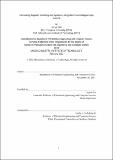| dc.description.abstract | Spintronics exploits the intrinsic spin of the electron in addition to its fundamental charge for designing next-generation electronic devices, with the purpose of reducing power consumption and enabling novel computing functions. The manipulation, transmission, and detection of spin information require effective control of the magnetic orientation and dynamics in magnetic materials, which can be realized by the interactions between magnetic moments and spin currents. In this thesis, we explore two types ofspin currents, as carried by conduction electrons and magnons, respectively, to realize efficient magnetic switching and transmission of dynamical spin signals.
Using electron spin current, we firstly demonstrated current-induced magnetic switching via the strong spin-orbit torque from topological insulators at room temperature. Secondly, we achieved spin-orbit torque switching of a ferromagnetic Weyl semimetal, where the topological properties are manipulated by the magnetic switching. Besides, spin wave can also transmit spin via magnon spin current. In the third work, we used magnetic domain walls to manipulate the phase and magnitude of a coherent spin wave, and in turn, investigated the domain wall motion driven by a spin wave. This mutual control can pave the way towards all-magnon computing devices. In the fourth work, we studied the nonreciprocal transmission of incoherent magnon currents in a magnetic bilayer, where dynamic interlayer dipolar interactions cause the asymmetric magnon diffusion. This effect is useful for designing signal isolation devices. Finally, we extended the material system from ferromagnets to antiferromagnets. We demonstrated long-distance spin transport in antiferromagnetic insulators with easy-plane anisotropy, where the magnon eigenmodes are linearly polarized and propagate in a birefringence manner.
To conclude, multiple opportunities for magnetic switching and spin transport have been explored under the usage of electron and magnon spin currents, which represents a remarkable advancement towards energy-efficient and highly tunable memory and computing technologies. | |
